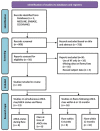Do Relapses Follow ANCA Rises? A Systematic Review and Meta-Analysis on the Value of Serial ANCA Level Evaluation
- PMID: 35860735
- PMCID: PMC9289208
- DOI: 10.3389/fmed.2022.844112
Do Relapses Follow ANCA Rises? A Systematic Review and Meta-Analysis on the Value of Serial ANCA Level Evaluation
Abstract
Objectives: ANCA-vasculitis (AAV) patients frequently suffer from relapses and risk subsequent organ damage. There is much debate on the value of serial ANCA level evaluation to monitor disease activity. We aimed to evaluate the association between ANCA rises and disease relapses at (I) moment of the rise, (II) within 6 months or (III) within a year from the rise.
Methods: 3 databases (MEDLINE, EMBASE, COCHRANE) were searched from 1993 through September 2021. We included studies that reported relapse incidence within 12 months after an ANCA rise measured by antigen-specific immunoassays in peripheral blood of AAV patients in remission. Quality assessment was performed using QUADAS-2. Finally, a meta-analysis was carried out to estimate average OR using a random effects model.
Results: Twenty unique studies were included. The methodological quality was limited due to risk of selection bias. An ANCA rise often preceded a disease relapse within 6 months (OR 3.65, 95% CI 1.66-8.03) and less often within 12 months (OR 2.88, 95% CI 1.21-6.88), while it was not indicative of a concurrent relapse (OR 0.13, 95% CI 0.03-0.53). Once a relapse is diagnosed, ANCA is significantly more often present than not (OR 10.80, 95% CI 3.82-30.55). As expected based on clinical, technical and methodological variability between studies, there was substantial heterogeneity across studies in all analyses (I2 = 70-87%).
Conclusion: In previously ANCA-positive patients, the ANCA test is often positive upon clinical suspicion of a disease relapse. Patients with a rise in ANCA are at risk of encountering disease relapses in the upcoming 6 or 12 months.
Keywords: ANCA-associated vasculitis (AAV); anti-neutrophil cytoplasmic antibodies (ANCA); biomarker (BM); flare; relapse.
Copyright © 2022 Al-Soudi, Vegting, Klarenbeek and Hilhorst.
Conflict of interest statement
The authors declare that the research was conducted in the absence of any commercial or financial relationships that could be construed as a potential conflict of interest.
Figures





Similar articles
-
Value of ANCA measurements during remission to predict a relapse of ANCA-associated vasculitis--a meta-analysis.Rheumatology (Oxford). 2012 Jan;51(1):100-9. doi: 10.1093/rheumatology/ker280. Epub 2011 Oct 29. Rheumatology (Oxford). 2012. PMID: 22039267 Free PMC article.
-
Seasonal Influence on the Risk of Relapse at a Rise of Antineutrophil Cytoplasmic Antibodies in Vasculitis Patients with Renal Involvement.J Rheumatol. 2017 Apr;44(4):473-481. doi: 10.3899/jrheum.160066. Epub 2017 Feb 15. J Rheumatol. 2017. PMID: 28202741
-
Prevalence and risk factors of relapse in patients with ANCA-associated vasculitis receiving cyclophosphamide induction: a systematic review and meta-analysis of large observational studies.Rheumatology (Oxford). 2021 Mar 2;60(3):1067-1079. doi: 10.1093/rheumatology/keaa667. Rheumatology (Oxford). 2021. PMID: 33677596
-
Serial ANCA titers: useful tool for prevention of relapses in ANCA-associated vasculitis.Kidney Int. 2003 Mar;63(3):1079-85. doi: 10.1046/j.1523-1755.2003.00821.x. Kidney Int. 2003. PMID: 12631091
-
The Role of Mycophenolate Mofetil for the Induction of Remission in ANCA-Associated Vasculitis: A Meta-Analysis.Front Med (Lausanne). 2021 Mar 1;8:609924. doi: 10.3389/fmed.2021.609924. eCollection 2021. Front Med (Lausanne). 2021. PMID: 33732714 Free PMC article.
Cited by
-
Diagnostic significance of antineutrophil cytoplasmic antibody (ANCA) titres: a retrospective case-control study.RMD Open. 2023 Apr;9(2):e003113. doi: 10.1136/rmdopen-2023-003113. RMD Open. 2023. PMID: 37055171 Free PMC article.
-
Clinical Characteristics of EGPA Patients in Comparison to GPA Subgroup with Increased Blood Eosinophilia from POLVAS Registry.J Immunol Res. 2024 Apr 25;2024:4283928. doi: 10.1155/2024/4283928. eCollection 2024. J Immunol Res. 2024. PMID: 38699219 Free PMC article.
-
Antineutrophil Cytoplasmic Antibodies (ANCAs): Role in Diagnosis, Disease Monitoring, and Prognosis.J Am Soc Nephrol. 2025 May 7;36(7):1428-1438. doi: 10.1681/ASN.0000000749. J Am Soc Nephrol. 2025. PMID: 40333015 Review.
-
Anti-myeloperoxidase IgM B cells in anti-neutrophil cytoplasmic antibody-associated vasculitis.Nat Commun. 2025 Feb 12;16(1):1582. doi: 10.1038/s41467-025-56786-x. Nat Commun. 2025. PMID: 39939347 Free PMC article.
-
Top ten tips in managing ANCA vasculitis.Clin Kidney J. 2024 Nov 30;18(2):sfae389. doi: 10.1093/ckj/sfae389. eCollection 2025 Feb. Clin Kidney J. 2024. PMID: 39927255 Free PMC article. Review.
References
-
- Berti A, Cornec-Le Gall E, Cornec D, Casal Moura M, Matteson EL, Crowson CS, et al. . Incidence, prevalence, mortality and chronic renal damage of anti-neutrophil cytoplasmic antibody-associated glomerulonephritis in a 20-year population-based cohort. Nephrol Dial Transplant. (2019) 34:1508–17. 10.1093/ndt/gfy250 - DOI - PMC - PubMed
Publication types
LinkOut - more resources
Full Text Sources
Research Materials

